Heavy Metals in Bottom Sediments of Reservoirs in the Lowland Area of Western Poland: Concentrations, Distribution, Sources and Ecological Risk
Abstract
1. Introduction
2. Materials and Methods
2.1. Study Area and Sampling Sites
2.2. Sample Collection and Preparation
2.3. Chemical Analysis
2.4. Quantification of Metal Pollution
2.4.1. Index of Geo-Accumulation
2.4.2. Enrichment Factor
2.4.3. Pollution Load Index
2.4.4. Metal Pollution Index
2.5. Ecological Risk Assessment
2.6. Distribution and Source Identification
3. Results
3.1. Heavy Metal Content
3.2. Bottom Sediment Pollution Assessment
3.3. Ecological Risk Assessment
3.4. Distribution and Source Identification
3.5. Relationships between HM Concentrations and Sediment Texture and Organic Matter Content
4. Discussion
5. Conclusions
- The content of HMs in bottom sediments is an individual feature of reservoirs.
- The PCA analysis and the values of Igeo, EF, MPI and PLI indices show that Cd, Cr, Cu, Ni and Pb in bottom sediments originate from geogenic sources – weathering of rock material. In contrast, Zn comes from anthropogenic sources.
- High variability of Zn concentrations between sampling sites and reservoirs confirms their origin from anthropogenic sources related to wastewater management.
- The PCA analysis indicates that the areas adjacent to reservoirs may have an impact on HM distribution, while the Ni concentration may additionally be affected by road traffic.
- In reservoirs with higher frequency of water exchange, higher HM concentrations were observed.
- The highest concentrations of HMs are observed at the inlet to the reservoir and near the dam, which causes the greatest ecological risk.
- The CA and PCA analysis show that the concentrations and spatial distribution of HMs depend on silt content. The Pb, Cu, Cd and Zn concentrations in reservoirs’ bottom sediments are associated with TOM content. However, the relation between individual HMs and silt was stronger than with TOM.
- Segregation of sediments along the reservoirs and the TOM content affect the concentrations and spatial distribution of HMs.
Author Contributions
Funding
Conflicts of Interest
References
- Sojka, M.; Jaskuła, J.; Wicher-Dysarz, J.; Dysarz, T. The Impact of the Kowalskie Reservoir on the Hydrological Regime Alteration of the Główna River. J. Ecol. Eng. 2016, 17, 91–98. [Google Scholar] [CrossRef]
- Vukovic, D.; Vukovic, Z.; Stankovic, S. The impact of the Danube Iron Gate Dam on heavy metal storage and sediment flux within the reservoir. Catena 2014, 113, 18–23. [Google Scholar] [CrossRef]
- Dąbrowska, J.; Kaczmarek, H.; Markowska, J.; Tyszkowski, S.; Kempa, O.; Gałęza, M.; Kucharczak-Moryl, E.; Moryl, A. Shore zone in protection of water quality in agricultural landscape—The Mściwojów Reservoir, southwestern Poland. Environ. Monit. Assess. 2016, 188, 467. [Google Scholar] [CrossRef] [PubMed]
- Sedláček, J.; Bábek, O.; Nováková, T. Sedimentary record and anthropogenic pollution of a complex, multiple source fed dam reservoirs: An example from the Nové Mlýny reservoir, Czech Republic. Sci. Total Environ. 2017, 574, 1456–1471. [Google Scholar] [CrossRef] [PubMed]
- Bai, J.; Cui, B.; Chen, B.; Zhang, K.; Deng, W.; Gao, H.; Xiao, R. Spatial distribution and ecological risk assessment of heavy metals in surface sediments from a typical plateau lake wetland, China. Ecol. Modell. 2011, 222, 301–306. [Google Scholar] [CrossRef]
- Palma, P.; Ledo, L.; Alvarenga, P. Assessment of trace element pollution and its environmental risk to freshwater sediments influenced by anthropogenic contributions: The case study of Alqueva reservoir (Guadiana Basin). Catena 2015, 128, 174–184. [Google Scholar] [CrossRef]
- Wang, Y.; Yang, L.; Kong, L.; Liu, E.; Wang, L.; Zhu, J. Spatial distribution, ecological risk assessment and source identification for heavy metals in surface sediments from Dongping Lake, Shandong, East China. Catena 2015, 125, 200–205. [Google Scholar] [CrossRef]
- Suresh, G.; Sutharsan, P.; Ramasamy, V.; Venkatachalapathy, R. Assessment of spatial distribution and potential ecological risk of the heavy metals in relation to granulometric contents of Veeranam lake sediments, India. Ecotoxicol. Environ. Saf. 2012, 84, 117–124. [Google Scholar] [CrossRef]
- Barut, I.F.; Ergin, M.; Meriç, E.; Avşar, N.; Nazik, A.; Suner, F. Contribution of natural and anthropogenic effects in the Iznik Lake bottom sediment: Geochemical and microfauna assemblages evidence. Quat. Int. 2018, 486, 129–142. [Google Scholar] [CrossRef]
- Yazidi, A.; Saidi, S.; Mbarek, N.B.; Darragi, F. Contribution of GIS to evaluate surface water pollution by heavy metals: Case of Ichkeul Lake (Northern Tunisia). J. Afr. Earth Sci. 2017, 134, 166–173. [Google Scholar] [CrossRef]
- Lee, P.K.; Kang, M.J.; Yu, S.; Ko, K.S.; Ha, K.; Shin, S.C.; Park, J.H. Enrichment and geochemical mobility of heavy metals in bottom sediment of the Hoedong reservoir, Korea and their source apportionment. Chemosphere 2017, 184, 74–85. [Google Scholar] [CrossRef] [PubMed]
- Pavlović, P.; Mitrović, M.; Đorđević, D.; Sakan, S.; Slobodnik, J.; Liška, I.; Csanyi, B.; Jarić, S.; Kostić, O.; Pavlović, D.; et al. Assessment of the contamination of riparian soil and vegetation by trace metals—A Danube River case study. Sci. Total Environ. 2016, 540, 396–409. [Google Scholar] [CrossRef] [PubMed]
- Wang, L.F.; Yang, L.Y.; Kong, L.H.; Li, S.; Zhu, J.R.; Wang, Y.Q. Spatial distribution, source identification and pollution assessment of metal content in the surface sediments of Nansi Lake, China. J. Geochem. Explor. 2014, 140, 87–95. [Google Scholar] [CrossRef]
- Wang, X.; Zhang, L.; Zhao, Z.; Cai, Y. Heavy metal pollution in reservoirs in the hilly area of southern China: Distribution, source apportionment and health risk assessment. Sci. Total Environ. 2018, 634, 158–169. [Google Scholar] [CrossRef] [PubMed]
- Noronha-D’Mello, C.A.; Nayak, G.N. Assessment of metal enrichment and their bioavailability in sediment and bioaccumulation by mangrove plant pneumatophores in a tropical (Zuari) estuary, west coast of India. Mar. Pollut. Bull. 2016, 110, 221–230. [Google Scholar] [CrossRef]
- Sojka, M.; Siepak, M.; Jaskuła, J.; Wicher-Dysarz, J. Heavy Metal Transport in a River-Reservoir System: A Case Study from Central Poland. Pol. J. Environ. Stud. 2018, 27, 1725–1734. [Google Scholar] [CrossRef]
- Frémion, F.; Courtin-Nomade, A.; Bordas, F.; Lenain, J.F.; Jugé, P.; Kestens, T.; Mourier, B. Impact of sediments resuspension on metal solubilization and water quality during recurrent reservoir sluicing management. Sci. Total Environ. 2016, 562, 201–215. [Google Scholar] [CrossRef]
- Wang, C.Y.; Wang, X.L. Spatial distribution of dissolved Pb, Hg, Cd, Cu and as in the Bohai sea. J. Environ. Sci. (China) 2007, 19, 1061–1066. [Google Scholar] [CrossRef]
- Wilson, D.C. Potential urban runoff impacts and contaminant distributions in shoreline and reservoir environments of Lake Havasu, southwestern United States. Sci. Total Environ. 2018, 621, 95–107. [Google Scholar] [CrossRef]
- Morris, G.L.; Fan, J. Reservoir Sedimentation Handbook: Design and Management of Dams, Reservoirs, and Watersheds for Sustainable Use; McGraw-Hill Publishing Co.: New York, NY, USA, 1998; ISBN 978-0070433021. [Google Scholar]
- Wang, Y.; Hu, J.; Xiong, K.; Huang, X.; Duan, S. Distribution of heavy metals in core sediments from Baihua Lake. Procedia Environ. Sci. 2012, 16, 51–58. [Google Scholar] [CrossRef]
- Yujun, Y.; Zhaoyin, W.; Zhang, K.; Guoan, Y.U.; Xuehua, D. Sediment pollution and its effect on fish through food chain in the Yangtze River. Int. J. Sediment Res. 2008, 23, 338–347. [Google Scholar] [CrossRef]
- Frémion, F.; Bordas, F.; Mourier, B.; Lenain, J.F.; Kestens, T.; Courtin-Nomade, A. Influence of dams on sediment continuity: A study case of a natural metallic contamination. Sci. Total Environ. 2016, 547, 282–294. [Google Scholar] [CrossRef] [PubMed]
- Redwan, M.; Elhaddad, E. Heavy metals seasonal variability and distribution in Lake Qaroun sediments, El-Fayoum, Egypt. J. Afr. Earth Sci. 2017, 134, 48–55. [Google Scholar] [CrossRef]
- Sojka, M.; Siepak, M.; Gnojska, E. Assessment of heavy metal concentration in bottom sediments of Stare Miasto pre-dam reservoir on the Powa river. Annu. Set Environ. Prot. 2013, 15, 1916–1928. [Google Scholar]
- Lin, Q.; Liu, E.; Zhang, E.; Li, K.; Shen, J. Spatial distribution, contamination and ecological risk assessment of heavy metals in surface sediments of Erhai Lake, a large eutrophic plateau lake in southwest China. Catena 2016, 145, 193–203. [Google Scholar] [CrossRef]
- Frankowski, M.; Sojka, M.; Zioła-Frankowska, A.; Siepak, M.; Murat-Błażejewska, S. Distribution of heavy metals in the Mała Wełna River system (western Poland). Oceanol. Hydrobiol. Stud. 2009, 38, 51–61. [Google Scholar] [CrossRef]
- Farhat, H.I.; Aly, W. Effect of site on sedimentological characteristics and metal pollution in two semi-enclosed embayments of great freshwater reservoir: Lake Nasser, Egypt. J. Afr. Earth Sci. 2018, 141, 194–206. [Google Scholar] [CrossRef]
- Lin, J.; Zhang, S.; Liu, D.; Yu, Z.; Zhang, L.; Cui, J.; Xie, K.; Li, T.; Fu, C. Mobility and potential risk of sediment-associated heavy metal fractions under continuous drought-rewetting cycles. Sci. Total Environ. 2018, 625, 79–86. [Google Scholar] [CrossRef]
- Martínez-Santos, M.; Probst, A.; García-García, J.; Ruiz-Romera, E. Influence of anthropogenic inputs and a high-magnitude flood event on metal contamination pattern in surface bottom sediments from the Deba River urban catchment. Sci. Total Environ. 2015, 514, 10–25. [Google Scholar] [CrossRef]
- Zhang, Z.; Juying, L.; Mamat, Z.; QingFu, Y. Sources identification and pollution evaluation of heavy metals in the surface sediments of Bortala River, Northwest China. Ecotoxicol. Environ. Saf. 2016, 126, 94–101. [Google Scholar] [CrossRef]
- Dong, A.; Zhai, S.; Zabel, M.; Yu, Z.; Zhang, H.; Liu, F. Heavy metals in Changjiang estuarine and offshore sediments: Responding to human activities. Acta Oceanol. Sin. 2012, 31, 88–101. [Google Scholar] [CrossRef]
- Dhanakumar, S.; Murthy, K.R.; Solaraj, G.; Mohanraj, R. Heavy-metal fractionation in surface sediments of the Cauvery River estuarine region, southeastern coast of India. Arch. Environ. Contam. Toxicol. 2013, 65, 14–23. [Google Scholar] [CrossRef] [PubMed]
- Zhang, C.; Yu, Z.G.; Zeng, G.M.; Jiang, M.; Yang, Z.Z.; Cui, F.; Zhu, M.; Shen, L.; Hu, L. Effects of sediment geochemical properties on heavy metal bioavailability. Environ. Int. 2014, 73, 270–281. [Google Scholar] [CrossRef] [PubMed]
- Graham, M.C.; Gavin, K.G.; Kirika, A.; Farmer, J.G. Processes controlling manganese distributions and associations in organic-rich freshwater aquatic systems: The example of Loch Bradan, Scotland. Sci. Total Environ. 2012, 424, 239–250. [Google Scholar] [CrossRef] [PubMed]
- Zhong, A.P.; Guo, S.H.; Li, F.M.; Gang, L.I.; Jiang, K.X. Impact of anions on the heavy metals release from marine sediments. J. Environ. Sci. 2006, 18, 1216–1220. [Google Scholar] [CrossRef]
- Du Laing, G.; De Vos, R.; Vandecasteele, B.; Lesage, E.; Tack, F.M.; Verloo, M.G. Effect of salinity on heavy metal mobility and availability in intertidal sediments of the Scheldt estuary. Estuar. Coast. Shelf Sci. 2008, 77, 589–602. [Google Scholar] [CrossRef]
- Dhanakumar, S.; Solaraj, G.; Mohanraj, R. Heavy metal partitioning in sediments and bioaccumulation in commercial fish species of three major reservoirs of river Cauvery delta region, India. Ecotoxicol. Environ. Saf. 2015, 113, 145–151. [Google Scholar] [CrossRef]
- Zhu, L.; Liu, J.; Xu, S.; Xie, Z. Deposition behavior, risk assessment and source identification of heavy metals in reservoir sediments of Northeast China. Ecotoxicol. Environ. Saf. 2017, 142, 454–463. [Google Scholar] [CrossRef]
- Yi, Y.; Yang, Z.; Zhang, S. Ecological risk assessment of heavy metals in sediment and human health risk assessment of heavy metals in fishes in the middle and lower reaches of the Yangtze River basin. Environ. Pollut. 2011, 159, 2575–2585. [Google Scholar] [CrossRef]
- Zhuang, W.; Liu, Y.; Chen, Q.; Wang, Q.; Zhou, F. A new index for assessing heavy metal contamination in sediments of the Beijing-Hangzhou Grand Canal (Zaozhuang Segment): A case study. Ecol. Indic. 2016, 69, 252–260. [Google Scholar] [CrossRef]
- Birch, G.F.; Apostolatos, C. Use of sedimentary metals to predict metal concentrations in black mussel (Mytilus galloprovincialis) tissue and risk to human health (Sydney estuary, Australia). Environ. Sci. Pollut. Res. Int. 2013, 20, 5481–5491. [Google Scholar] [CrossRef] [PubMed]
- Bing, H.; Wu, Y.; Zhou, J.; Sun, H.; Wang, X.; Zhu, H. Spatial variation of heavy metal contamination in the riparian sediments after two-year flow regulation in the Three Gorges Reservoir, China. Sci. Total Environ. 2019, 649, 1004–1016. [Google Scholar] [CrossRef] [PubMed]
- Song, J.; Duan, X.; Han, X.; Li, Y.; Li, Y.; He, D. The accumulation and redistribution of heavy metals in the water-level fluctuation zone of the Nuozhadu Reservoir, Upper Mekong. Catena 2019, 172, 335–344. [Google Scholar] [CrossRef]
- Fathollahzadeh, H.; Kaczala, F.; Bhatnagar, A.; Hogland, W. Significance of environmental dredging on metal mobility from contaminated sediments in the Oskarshamn Harbor, Sweden. Chemosphere 2015, 119, 445–451. [Google Scholar] [CrossRef] [PubMed]
- Wang, C.; Liu, S.; Zhao, Q.; Deng, L.; Dong, S. Spatial variation and contamination assessment of heavy metals in sediments in the Manwan Reservoir, Lancang River. Ecotoxicol. Environ. Saf. 2012, 82, 32–39. [Google Scholar] [CrossRef]
- Peraza-Castro, M.; Sauvage, S.; Sánchez-Pérez, J.M.; Ruiz-Romera, E. Effect of flood events on transport of suspended sediments, organic matter and particulate metals in a forest watershed in the Basque Country (Northern Spain). Sci. Total Environ. 2016, 569, 784–797. [Google Scholar] [CrossRef]
- Hahn, J.; Opp, C.; Evgrafova, A.; Groll, M.; Zitzer, N.; Laufenberg, G. Impacts of dam draining on the mobility of heavy metals and arsenic in water and basin bottom sediments of three studied dams in Germany. Sci. Total Environ. 2018, 640, 1072–1081. [Google Scholar] [CrossRef]
- Fu, K.D.; Su, B.; He, D.M.; Lu, X.X.; Song, J.Y.; Huang, J.C. Pollution assessment of heavy metals along the Mekong River and dam effects. J. Geogr. Sci. 2012, 22, 874–884. [Google Scholar] [CrossRef]
- Zhao, Q.; Liu, S.; Deng, L.; Dong, S.; Wang, C. Longitudinal distribution of heavy metals in sediments of a canyon reservoir in Southwest China due to dam construction. Environ. Monit. Assess. 2013, 185, 6101–6110. [Google Scholar] [CrossRef]
- Dai, Z.; Liu, J.T. Impacts of large dams on downstream fluvial sedimentation: An example of the Three Gorges Dam (TGD) on the Changjiang (Yangtze River). J. Hydrol. 2013, 480, 10–18. [Google Scholar] [CrossRef]
- Palma, P.; Ledo, L.; Soares, S.; Barbosa, I.R.; Alvarenga, P. Spatial and temporal variability of the water and sediments quality in the Alqueva reservoir (Guadiana Basin; southern Portugal). Sci. Total Environ. 2014, 470, 780–790. [Google Scholar] [CrossRef] [PubMed]
- Li, F.; Zhang, J.; Liu, C.; Xiao, M.; Wu, Z. Distribution, bioavailability and probabilistic integrated ecological risk assessment of heavy metals in sediments from Honghu Lake, China. Process. Saf. Environ. Prot. 2018, 116, 169–179. [Google Scholar] [CrossRef]
- Zhang, C.; Shan, B.; Zhao, Y.; Song, Z.; Tang, W. Spatial distribution, fractionation, toxicity and risk assessment of surface sediments from the Baiyangdian Lake in northern China. Ecol. Indic. 2018, 90, 633–642. [Google Scholar] [CrossRef]
- Saleem, M.; Iqbal, J.; Akhter, G.; Shah, M.H. Fractionation, bioavailability, contamination and environmental risk of heavy metals in the sediments from a freshwater reservoir, Pakistan. J. Geochem. Explor. 2018, 184, 199–208. [Google Scholar] [CrossRef]
- Dummee, V.; Kruatrachue, M.; Trinachartvanit, W.; Tanhan, P.; Pokethitiyook, P.; Damrongphol, P. Bioaccumulation of heavy metals in water, sediments, aquatic plant and histopathological effects on the golden apple snail in Beung Boraphet reservoir, Thailand. Ecotoxicol. Environ. Saf. 2012, 86, 204–212. [Google Scholar] [CrossRef] [PubMed]
- Ji, H.; Ding, H.; Tang, L.; Li, C.; Gao, Y.; Briki, M. Chemical composition and transportation characteristic of trace metals in suspended particulate matter collected upstream of a metropolitan drinking water source, Beijing. J. Geochem. Explor. 2016, 169, 123–136. [Google Scholar] [CrossRef]
- Bing, H.; Zhou, J.; Wu, Y.; Wang, X.; Sun, H.; Li, R. Current state, sources, and potential risk of heavy metals in sediments of Three Gorges Reservoir, China. Environ. Pollut. 2016, 214, 485–496. [Google Scholar] [CrossRef]
- Hanif, N.; Eqani, S.A.M.A.S.; Ali, S.M.; Cincinelli, A.; Ali, N.; Katsoyiannis, I.A.; Tanveer, Z.I.; Bokhari, H. Geo-accumulation and enrichment of trace metals in sediments and their associated risks in the Chenab River, Pakistan. J. Geochem. Explor. 2016, 165, 62–70. [Google Scholar] [CrossRef]
- El-Amier, Y.A.; Elnaggar, A.; El-Alfy, M.A. Evaluation and mapping spatial distribution of bottom sediment heavy metal contamination in Burullus Lake, Egypt. Egypt. J. Basic Appl. Sci. 2017, 4, 55–66. [Google Scholar] [CrossRef]
- Ali, M.M.; Ali, M.L.; Islam, M.S.; Rahman, M.Z. Preliminary assessment of heavy metals in water and sediment of Karnaphuli River, Bangladesh. Environ. Nanotechnol. Monit. Manag. 2016, 5, 27–35. [Google Scholar] [CrossRef]
- Audry, S.; Schäfer, J.; Blanc, G.; Jouanneau, J.M. Fifty-year sedimentary record of heavy metal pollution (Cd, Zn, Cu, Pb) in the Lot River reservoirs (France). Environ. Pollut. 2004, 132, 413–426. [Google Scholar] [CrossRef] [PubMed]
- Bian, B.; Zhou, Y.; Fang, B.B. Distribution of heavy metals and benthic macroinvertebrates: Impacts from typical inflow river sediments in the Taihu Basin, China. Ecol. Indic. 2016, 69, 348–359. [Google Scholar] [CrossRef]
- El-Sayed, S.A.; Moussa, E.M.M.; El-Sabagh, M.E.I. Evaluation of heavy metal content in Qaroun Lake, El-Fayoum, Egypt. Part I: Bottom sediments. J. Radiat. Res. Appl. Sci. 2015, 8, 276–285. [Google Scholar] [CrossRef]
- Gu, J.; Salem, A.; Chen, Z. Lagoons of the Nile delta, Egypt, heavy metal sink: With a special reference to the Yangtze estuary of China. Estuar. Coast. Shelf Sc. 2013, 117, 282–292. [Google Scholar] [CrossRef]
- Mohamaden, M.I.; Khalil, M.K.; Draz, S.E.; Hamoda, A.Z. Ecological risk assessment and spatial distribution of some heavy metals in surface sediments of New Valley, Western Desert, Egypt. Egypt. J. Aquat. Res. 2017, 43, 31–43. [Google Scholar] [CrossRef]
- Zahra, A.; Hashmi, M.Z.; Malik, R.N.; Ahmed, Z. Enrichment and geo-accumulation of heavy metals and risk assessment of sediments of the Kurang Nallah—Feeding tributary of the Rawal Lake Reservoir, Pakistan. Sci. Total Environ. 2014, 470, 925–933. [Google Scholar] [CrossRef] [PubMed]
- Zhang, W.; Feng, H.; Chang, J.; Qu, J.; Xie, H.; Yu, L. Heavy metal contamination in surface sediments of Yangtze River intertidal zone: An assessment from different indexes. Environ. Pollut. 2009, 157, 1533–1543. [Google Scholar] [CrossRef]
- Lario, J.; Alonso-Azcárate, J.; Spencer, C.; Zazo, C.; Goy, J.L.; Cabero, A.; Dabrio, C.J.; Borja, F.; Borja, C.; Civis, J.; et al. Evolution of the pollution in the Piedras river natural site (Gulf of cadiz, southern Spain) during the holocene. Environ. Earth Sci. 2016, 75, 481. [Google Scholar] [CrossRef]
- Wang, G.; Yinglan, A.; Jiang, H.; Fu, Q.; Zheng, B. Modeling the source contribution of heavy metals in surficial sediment and analysis of their historical changes in the vertical sediments of a drinking water reservoir. J. Hydrol. 2015, 520, 37–51. [Google Scholar] [CrossRef]
- Li, F.; Huang, J.; Zeng, G.; Yuan, X.; Li, X.; Liang, J.; Wang, X.; Tang, X.; Bai, B. Spatial risk assessment and sources identification of heavy metals in surface sediments from the Dongting Lake, Middle China. J. Geochem. Explor. 2013, 132, 75–83. [Google Scholar] [CrossRef]
- Wang, L.; Dai, L.; Li, L.; Liang, T. Multivariable cokriging prediction and source analysis of potentially toxic elements (Cr, Cu, Cd, Pb, and Zn) in surface sediments from Dongting Lake, China. Ecol. Indic. 2018, 94, 312–319. [Google Scholar] [CrossRef]
- Siepak, M.; Sojka, M. Application of multivariate statistical approach to identify trace elements sources in surface waters: A case study of Kowalskie and Stare Miasto reservoirs, Poland. Environ. Monit. Assess. 2017, 189, 364. [Google Scholar] [CrossRef] [PubMed]
- Sojka, M.; Siepak, M.; Zioła, A.; Frankowski, M.; Murat-Błażejewska, S. Application of multivariate statistical techniques to evaluation of water quality in the Mała Wełna River (Western Poland). Environ. Monit. Assess. 2008, 147, 159–170. [Google Scholar] [CrossRef] [PubMed]
- Sojka, M.; Siepak, M.; Pietrewicz, K. Concentration of Rare Earth Elements in surface water and bottom sediments in Lake Wadąg, Poland. J. Elem. 2019, 24, 125–140. [Google Scholar] [CrossRef]
- Przybyła, C.; Kozdrój, P.; Sojka, M. Application of Multivariate Statistical Methods in Water Quality Assessment of River-reservoirs Systems (on the Example of Jutrosin and Pakosław Reservoirs, Orla Basin). Annu. Set Environ. Prot. 2015, 17, 1125–1141. [Google Scholar]
- Ye, C.; Li, S.; Zhang, Y.; Zhang, Q. Assessing soil heavy metal pollution in the water-level-fluctuation zone of the Three Gorges Reservoir, China. J. Hazard Mater. 2011, 191, 366–372. [Google Scholar] [CrossRef] [PubMed]
- Wu, Q.; Qi, J.; Xia, X. Long-term variations in sediment heavy metals of a reservoir with changing trophic states: Implications for the impact of climate change. Sci. Total Environ. 2017, 609, 242–250. [Google Scholar] [CrossRef] [PubMed]
- Sojka, M. Assessment of biogenic compounds eluted from the catchment of Dembina river. Annu. Set Environ. Prot. 2009, 11, 1225–1234. [Google Scholar]
- Sojka, M.; Murat-Błażejewska, S. Physico-chemical and hydromorphological state of a small lowland river. Annu. Set Environ. Prot. 2009, 11, 727–737. [Google Scholar]
- Sojka, M.; Korytowski, M.; Jaskuła, J.; Waligórski, B. Assessment of vulnerability to degradation of the Przebędowo reservoir. J. Ecol. Eng. 2017, 18, 118–125. [Google Scholar] [CrossRef]
- Sojka, M.; Jaskuła, J.; Wicher-Dysarz, J.; Dysarz, T. Analysis of selected reservoirs functioning in the Wielkopolska region. Acta Sci. Pol. Formatio Circumiectus 2017, 16, 205–215. [Google Scholar] [CrossRef]
- Jaskuła, J.; Sojka, M.; Wicher-Dysarz, J. Analysis of the vegetation process in a two-stage reservoir on the basis of satellite imagery - a case study: Radzyny reservoir on the Sama river. Annu. Set Environ. Prot. 2018, 20, 203–220. [Google Scholar]
- Sojka, M.; Jaskuła, J.; Wróżyński, R.; Waligórski, B. Application of Sentinel-2 satellite imagery to assessment of spatio-temporal changes in the reservoir overgrowth process—A case study: Przebędowo, West Poland. Carpath. J. Earth Environ. 2019, 14, 39–50. [Google Scholar] [CrossRef]
- Baran, A.; Tarnawski, M.; Koniarz, T. Spatial distribution of trace elements and ecotoxicity of bottom sediments in Rybnik reservoir, Silesian-Poland. Environ. Sci. Pollut. Res. Int. 2016, 23, 17255–17268. [Google Scholar] [CrossRef] [PubMed]
- Wiatkowski, M. Problems of water management in the reservoir Młyny located on the Julianpolka river. Acta Sci. Pol. Formatio Circumiectus 2015, 14, 191–203. [Google Scholar] [CrossRef]
- Kasperek, R.; Wiatkowski, M. Bottom studies of Mściwojów reservoir. Sci. Rev. Eng. Environ. Sci. 2008, 17, 194–201. [Google Scholar]
- Smal, H.; Ligęza, S.; Wójcikowska-Kapusta, A.; Baran, S.; Urban, D.; Obroślak, R.; Pawłowski, A. Spatial distribution and risk assessment of heavy metals in bottom sediments of two small dam reservoirs (south-east Poland). Arch. Environ. Prot. 2015, 41, 67–80. [Google Scholar] [CrossRef]
- Cymes, I.; Glińska-Lewczuk, K.; Szymczyk, S.; Sidoruk, M.; Potasznik, A. Distribution and potential risk assessment of heavy metals and arsenic in sediments of a dam reservoir: A case study of the Łoje Retention Reservoir, NE Poland. J. Elem. 2017, 22, 843–856. [Google Scholar] [CrossRef]
- Łabędzki, L. Estimation of local drought frequency in central Poland using the standardized precipitation index SPI. Irrig. Drainage 2007, 56, 67–77. [Google Scholar] [CrossRef]
- Ostrowska, A.; Gawliński, S.; Szczubiałka, Z. Methods of Analysis and Assessment of Soil and Plant Properties; Environmental Protection Institute: Warsaw, Poland, 1991. [Google Scholar]
- Müller, G. Schwermetalle in den Sedimenten des Rheins—Veränderungen seit 1971. Umschau 1979, 79, 778–783. [Google Scholar]
- Benhaddya, M.L.; Hadjel, M. Spatial distribution and contamination assessment of heavy metals in surface soils of Hassi Messaoud, Algeria. Environ. Earth Sci. 2014, 71, 1473–1486. [Google Scholar] [CrossRef]
- Deely, J.M.; Fergusson, J.E. Heavy metal and organic matter concentrations and distributions in dated sediments of a small estuary adjacent to a small urban area. Sci. Total Environ. 1994, 153, 97–111. [Google Scholar] [CrossRef]
- Ergin, M.; Saydam, C.; Baştürk, Ö.; Erdem, E.; Yörük, R. Heavy metal concentrations in surface sediments from the two coastal inlets (Golden Horn Estuary and Izmit Bay) of the northeastern Sea of Marmara. Chem. Geol. 1991, 91, 269–285. [Google Scholar] [CrossRef]
- Aiman, U.; Mahmood, A.; Waheed, S.; Malik, R.N. Enrichment, geo-accumulation and risk surveillance of toxic metals for different environmental compartments from Mehmood Booti dumping site, Lahore city, Pakistan. Chemosphere 2016, 144, 2229–2237. [Google Scholar] [CrossRef]
- Islam, M.S.; Ahmed, M.K.; Raknuzzaman, M.; Habibullah-Al-Mamun, M.; Islam, M.K. Heavy metal pollution in surface water and sediment: A preliminary assessment of an urban river in a developing country. Ecol. Indic. 2015, 48, 282–291. [Google Scholar] [CrossRef]
- Al Rashdi, S.; Arabi, A.A.; Howari, F.M.; Siad, A. Distribution of heavy metals in the coastal area of Abu Dhabi in the United Arab Emirates. Mar. Pollut. Bull. 2015, 97, 494–498. [Google Scholar] [CrossRef] [PubMed]
- Sakan, S.M.; Đorđević, D.S.; Manojlović, D.D.; Predrag, P.S. Assessment of heavy metal pollutants accumulation in the Tisza river sediments. J. Environ. Manag. 2009, 90, 3382–3390. [Google Scholar] [CrossRef] [PubMed]
- Tomlinson, D.L.; Wilson, J.G.; Harris, C.R.; Jeffrey, D.W. Problems in the assessment of heavy-metal levels in estuaries and the formation of a pollution index. Helgol. Mar. Res. 1980, 33, 566–575. [Google Scholar] [CrossRef]
- Harikumar, P.S.; Nasir, U.P.; Rahman, M.M. Distribution of heavy metals in the core sediments of a tropical wetland system. Int. J. Environ. Sci. Technol. 2009, 6, 225–232. [Google Scholar] [CrossRef]
- Usero, J.; Morillo, J.; Gracia, I. Heavy metal concentrations in molluscs from the Atlantic coast of southern Spain. Chemosphere 2005, 59, 1175–1181. [Google Scholar] [CrossRef]
- Bojakowska, I.; Sokołowska, G. Geochemiczne klasy czystości osadów wodnych. Przegląd Geologiczny 1998, 46, 49–54. [Google Scholar]
- MacDonald, D.D.; Ingersoll, C.G.; Berger, T.A. Development and evaluation of consensus-based sediment quality guidelines for freshwater ecosystems. Arch. Environ. Contam. Toxicol. 2000, 39, 20–31. [Google Scholar] [CrossRef] [PubMed]
- Fu, J.; Zhao, C.; Luo, Y.; Liu, C.; Kyzas, G.Z.; Luo, Y.; Zhu, H. Heavy metals in surface sediments of the Jialu River. China: Their relations to environmental factors. J. Hazard Mater. 2014, 270, 102–109. [Google Scholar] [CrossRef] [PubMed]
- Lecce, S.A.; Pavlowsky, R.T. Floodplain storage of sediment contaminated by mercury and copper from historic gold mining at Gold Hill. North Carolina. USA. Geomorphology 2014, 206, 122–132. [Google Scholar] [CrossRef]
- Zhang, G.; Bai, J.; Zhao, Q.; Lu, Q.; Jia, J.; Wen, X. Heavy metals in wetland soils along a wetland-forming chronosequence in the Yellow River Delta of China: Levels, sources and toxic risks. Ecol. Indic. 2016, 69, 331–339. [Google Scholar] [CrossRef]
- Long, E.R.; MacDonald, D.D. Recommended uses of empirically derived. sediment quality guidelines for marine and estuarine ecosystems. Hum. Ecol. Risk Assess. 1998, 4, 1019–1039. [Google Scholar] [CrossRef]
- Ptak, M.; Sojka, M.; Choiński, A.; Nowak, B. Effect of Environmental Conditions and Morphometric Parameters on Surface Water Temperature in Polish Lakes. Water 2018, 10, 580. [Google Scholar] [CrossRef]
- Glińska-Lewczuk, K.; Burandt, P.; Kujawa, R.; Kobus, S.; Obolewski, K.; Dunalska, J.; Grabowska, M.; Lew, S.; Chormański, J. Environmental factors structuring fish communities in floodplain lakes of the undisturbed system of the Biebrza River. Water 2016, 8, 146. [Google Scholar] [CrossRef]
- Liu, C.W.; Lin, K.H.; Kuo, Y.M. Application of factor analysis in the assessment of groundwater quality in blackfoot disease in Taiwan. Sci. Total Environ. 2003, 313, 77–89. [Google Scholar] [CrossRef]
- Yongming, H.; Peixuan, D.; Junji, C.; Posmentier, E.S. Multivariate analysis of heavy metal contamination in urban dusts of Xi’an, Central China. Sci. Total Environ. 2006, 355, 176–186. [Google Scholar] [CrossRef]
- Zhang, J.; Liu, C.L. Riverine composition and estuarine geochemistry of particulate metals in China—Weathering features, anthropogenic impact and chemical fluxes. Estuar. Coast. Shelf Sci. 2002, 54, 1051–1070. [Google Scholar] [CrossRef]
- Haziak, T.; Czaplicka-Kotas, A.; Ślusarczyk, Z.; Szalińska, E. Spatial changes of zinc concentrations in the Czorsztyn reservoir sediments. Eng. Prot. Environ. 2013, 16, 57–68. [Google Scholar]
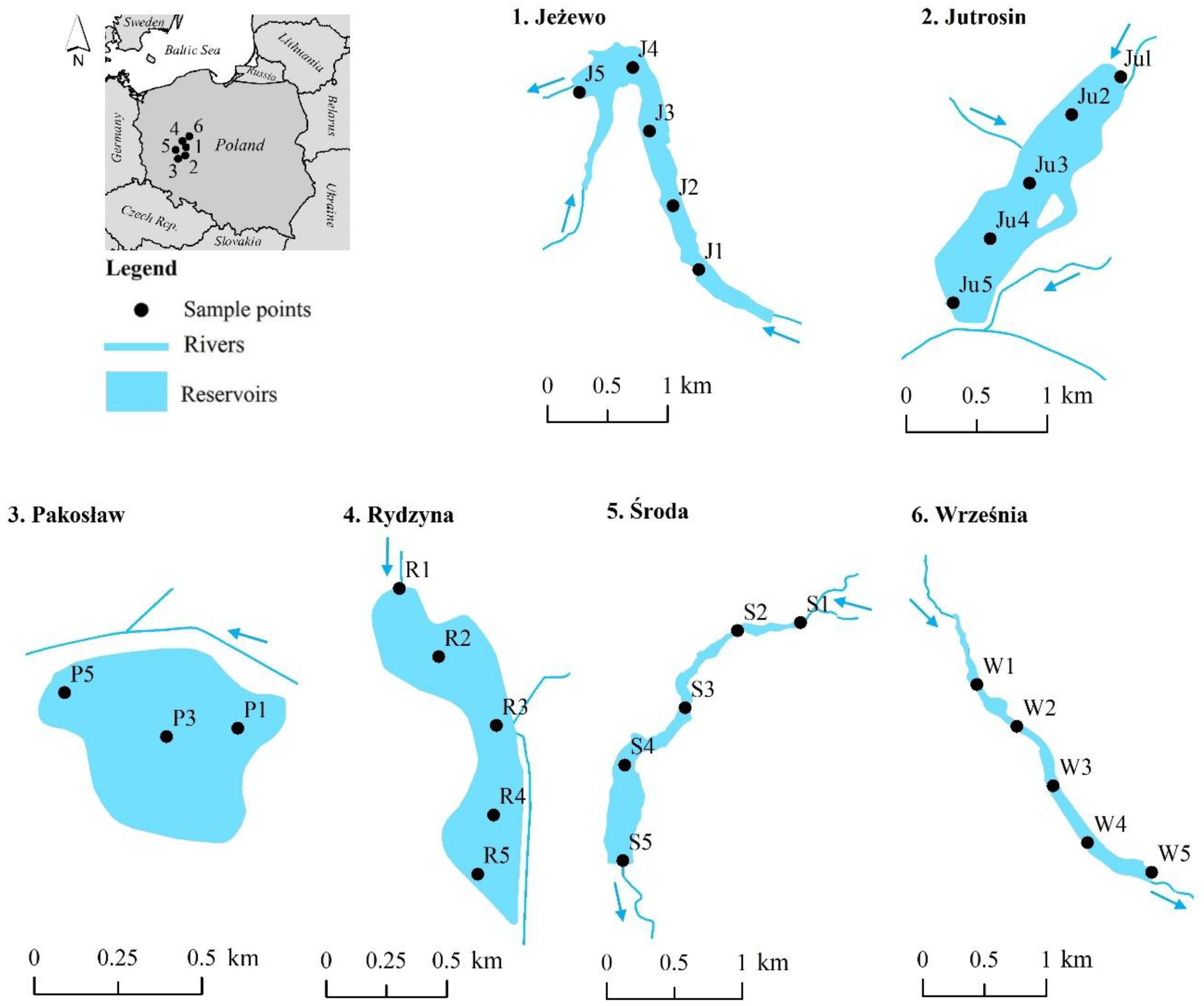
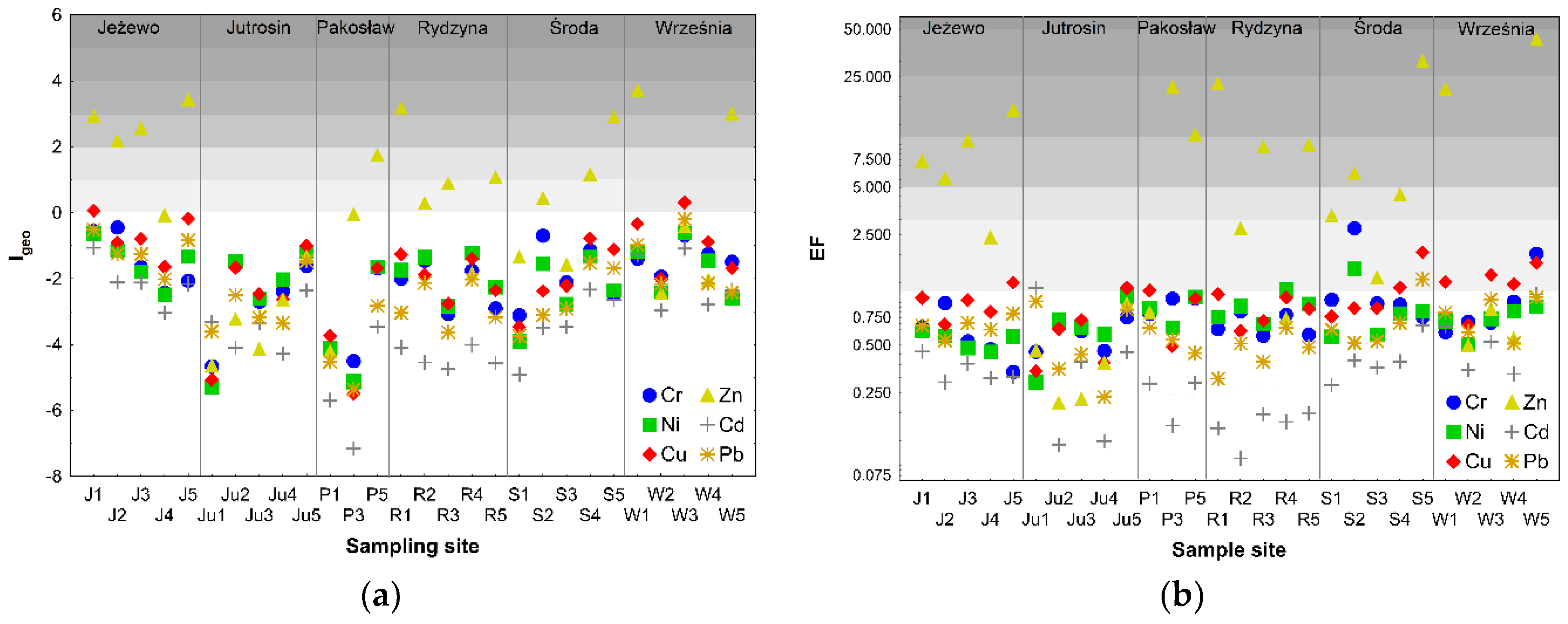
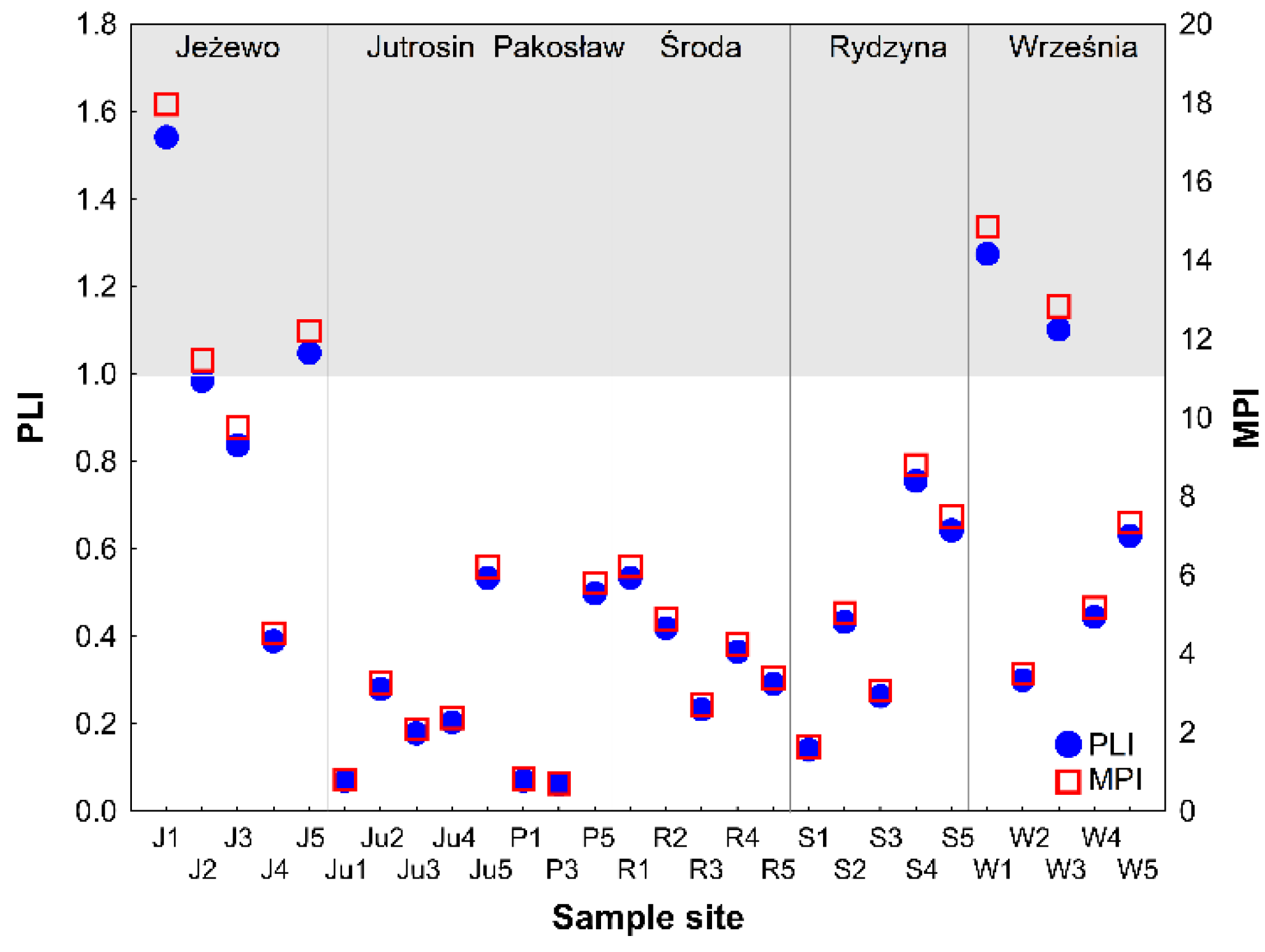
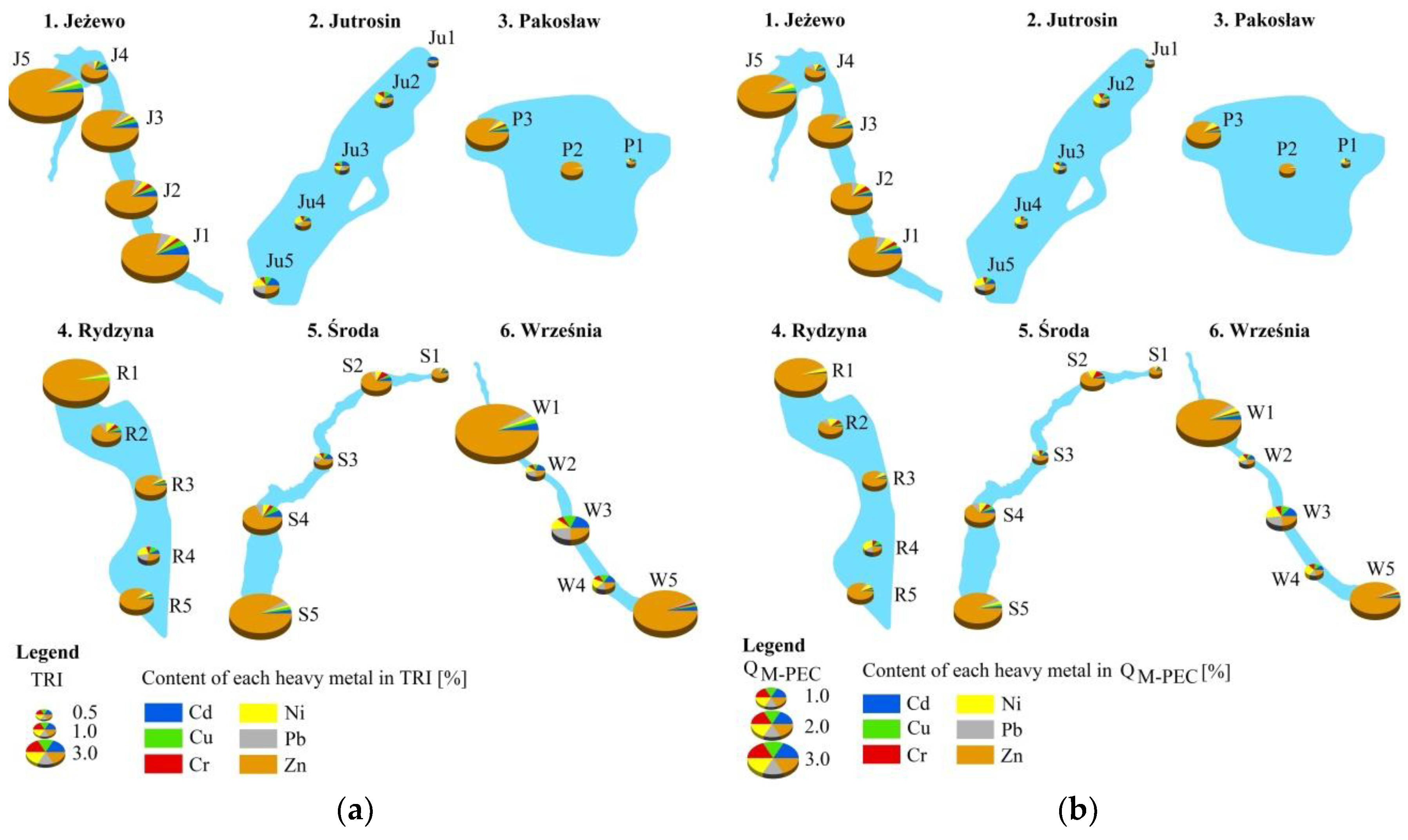
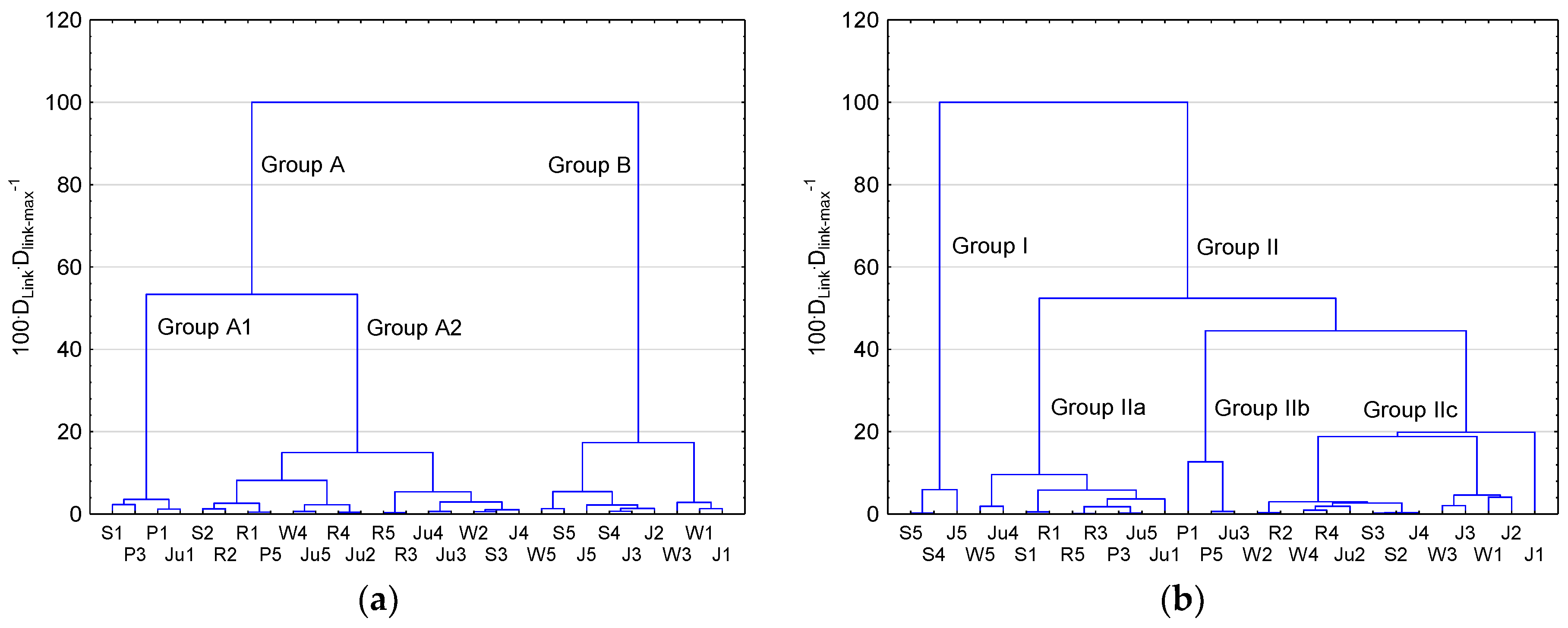
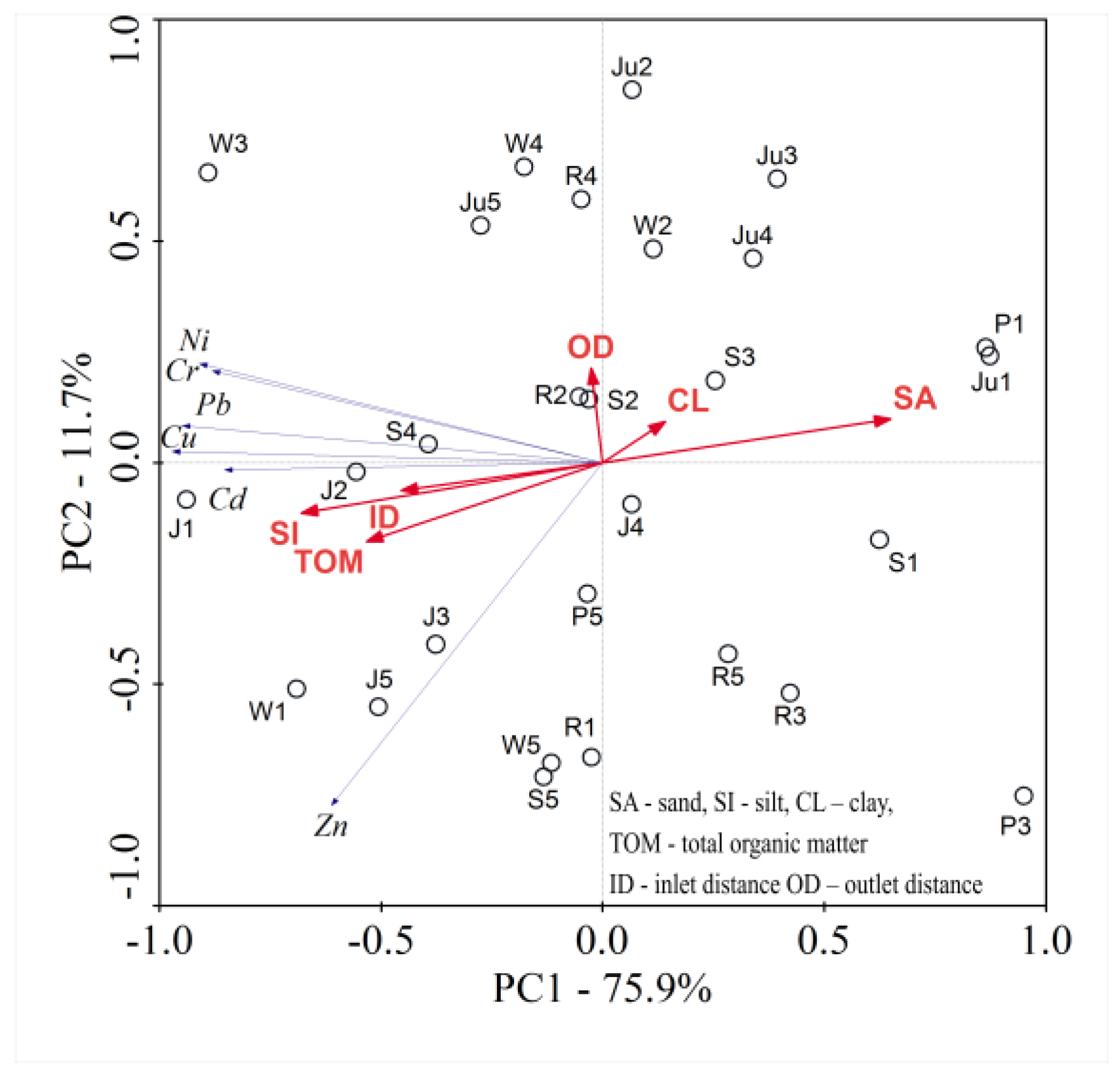
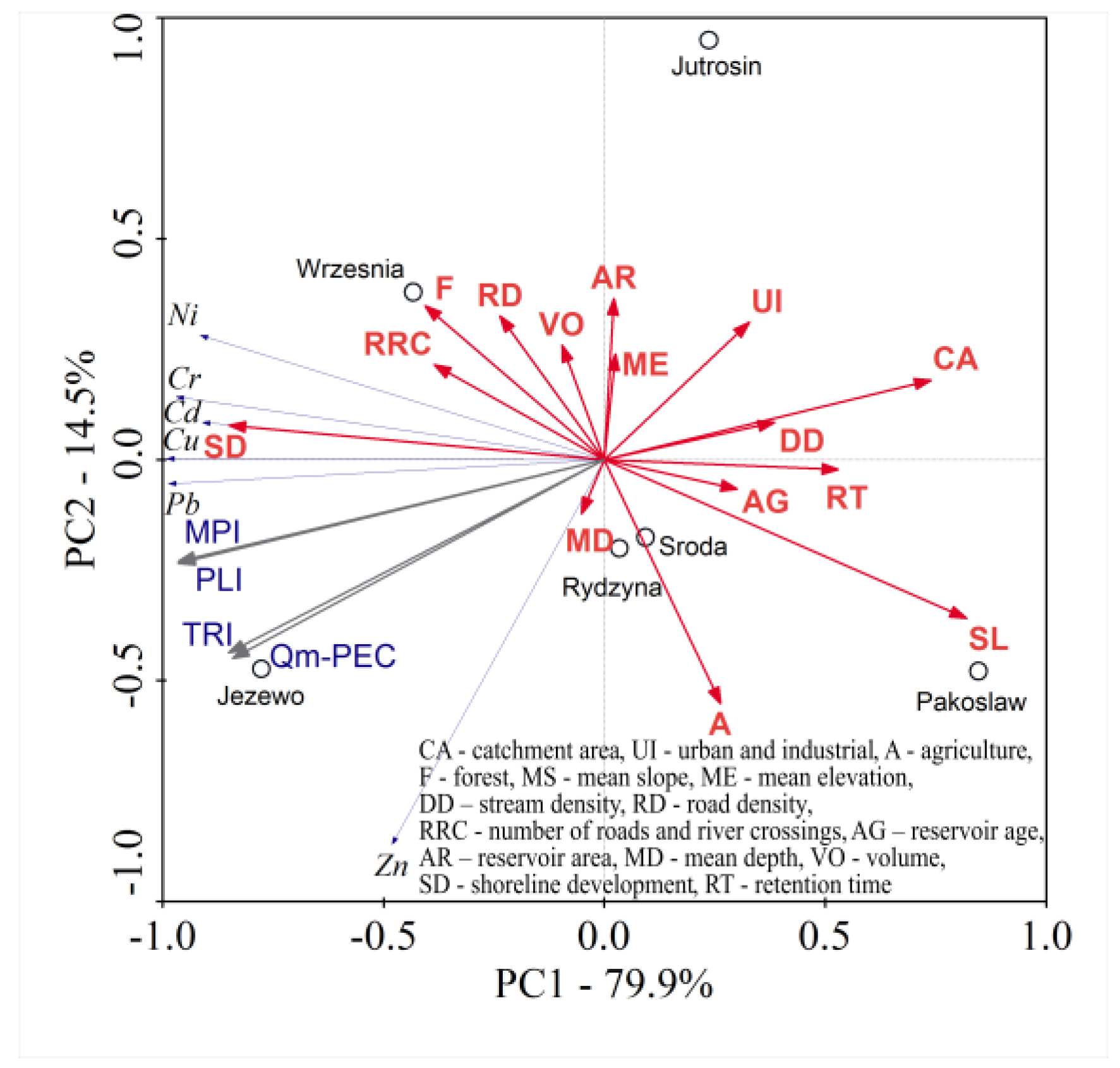
| Parameter | Jeżewo | Jutrosin | Pakosław | Rydzyna | Środa | Września |
|---|---|---|---|---|---|---|
| Reservoir characteristics | ||||||
| Start of functioning—AG (year) | 2003 | 2011 | 2006 | 2013 | 1971 | 1967 |
| X coordinate of centroid | 51°57′15.523” | 51°39′51.876” | 51°35′25.904” | 51°48′15.419” | 52°14′33.014” | 52°20′27.316” |
| Y coordinate of centroid | 17°14′9.603” | 17°10′29.229” | 17°3′35.704” | 16°39′10.306” | 17°17′38.652” | 17°32′28.053” |
| Area—AR (ha) | 73 | 91 | 54 | 41 | 39 | 33 |
| Mean depth—MD (m) 1 | 2.9 | 2.7 | 1.9 | 2.3 | 2.3 | 0.9 |
| Volume—VO (million m3) | 2.1 | 2.4 | 1.0 | 1.0 | 0.9 | 0.3 |
| Shoreline development—SD (-) | 2.8 | 1.6 | 0.8 | 1.6 | 2.7 | 2.9 |
| Hydrological conditions | ||||||
| Retention time—RT (d) | 77 | 122 | 122 | 109 | 23 | 4 |
| Catchment characteristics | ||||||
| Catchment area—CA (km2) | 104.1 | 517.6 | 773.5 | 24.3 | 148.5 | 272.5 |
| Mean elevation—ME (m a.s.l.) | 126.3 | 128.7 | 123.9 | 104.5 | 104.5 | 114.8 |
| Mean slope—MS (°) | 0.4 | 0.4 | 0.5 | 0.4 | 0.5 | 0.4 |
| Urban/Industry—UI (%) | 4 | 6 | 5 | 7 | 2 | 2 |
| Agriculture—A (%) | 79 | 84 | 78 | 75 | 81 | 68 |
| Forest—F (%) | 17 | 10 | 17 | 18 | 17 | 30 |
| Stream density—DD (km·km−2) | 1.9 | 2.1 | 2.3 | 1.2 | 1.6 | 1.7 |
| Road density—RD (km·km−2) | 1.0 | 1.0 | 0.9 | 1.1 | 1.0 | 1.0 |
| Road and river crossings—RRC (no.· km−2) | 0.8 | 0.7 | 0.6 | 0.7 | 0.5 | 0.6 |
| Reservoir | Cd | Cr | Cu | Ni | Pb | Zn |
|---|---|---|---|---|---|---|
| Jeżewo | 0.18-0.72 0.4 | 2.79-11.0 6.5 | 4.80-15.7 10.1 | 2.68-9.66 5.9 | 9.29-26.1 17.6 | 143.6-1639.6 903.7 |
| Jutrosin | 0.08-0.29 0.2 | 0.60-5.01 3.1 | 0.45-7.48 3.6 | 0.38-6.61 3.7 | 3.12-13.6 6.2 | 6.08-60.1 23.1 |
| Pakosław | 0.01-0.14 0.1 | 0.66-4.66 2.0 | 0.33-4.67 2.0 | 0.44-4.80 2.0 | 0.91-5.28 2.6 | 8.23-510.7 221.7 |
| Rydzyna | 0.06-0.09 0.1 | 1.79-5.48 3.5 | 2.22-6.27 4.2 | 2.11-6.42 4.4 | 3.05-9.23 5.9 | 42.2-1355.9 436.5 |
| Środa | 0.05-0.30 0.2 | 1.73-9.25 4.8 | 1.36-8.73 4.6 | 1.01-5.99 3.5 | 2.81-13.0 7.4 | 50.8-1131.7 357.5 |
| Września | 0.19-0.71 0.4 | 3.91-9.32 6.1 | 3.74-18.7 9.4 | 2.47-9.82 5.5 | 7.04-32.8 15.2 | 27.8-1990.4 678.4 |
© 2018 by the authors. Licensee MDPI, Basel, Switzerland. This article is an open access article distributed under the terms and conditions of the Creative Commons Attribution (CC BY) license (http://creativecommons.org/licenses/by/4.0/).
Share and Cite
Sojka, M.; Jaskuła, J.; Siepak, M. Heavy Metals in Bottom Sediments of Reservoirs in the Lowland Area of Western Poland: Concentrations, Distribution, Sources and Ecological Risk. Water 2019, 11, 56. https://doi.org/10.3390/w11010056
Sojka M, Jaskuła J, Siepak M. Heavy Metals in Bottom Sediments of Reservoirs in the Lowland Area of Western Poland: Concentrations, Distribution, Sources and Ecological Risk. Water. 2019; 11(1):56. https://doi.org/10.3390/w11010056
Chicago/Turabian StyleSojka, Mariusz, Joanna Jaskuła, and Marcin Siepak. 2019. "Heavy Metals in Bottom Sediments of Reservoirs in the Lowland Area of Western Poland: Concentrations, Distribution, Sources and Ecological Risk" Water 11, no. 1: 56. https://doi.org/10.3390/w11010056
APA StyleSojka, M., Jaskuła, J., & Siepak, M. (2019). Heavy Metals in Bottom Sediments of Reservoirs in the Lowland Area of Western Poland: Concentrations, Distribution, Sources and Ecological Risk. Water, 11(1), 56. https://doi.org/10.3390/w11010056







